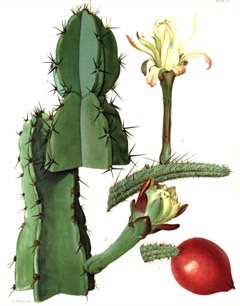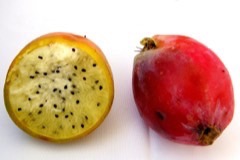 |
|
edibleplants.org |
 |
| wikimedia.org Rickjpelleg |
Translate this page:
Summary
Physical Characteristics

 Cereus hildmannianus is an evergreen Tree growing to 9 m (29ft) by 4.5 m (14ft) at a slow rate.
Cereus hildmannianus is an evergreen Tree growing to 9 m (29ft) by 4.5 m (14ft) at a slow rate.
See above for USDA hardiness. It is hardy to UK zone 9. The flowers are pollinated by Bees.
Suitable for: light (sandy) and medium (loamy) soils and prefers well-drained soil. Suitable pH: mildly acid and neutral soils. It cannot grow in the shade. It prefers dry or moist soil and can tolerate drought.
UK Hardiness Map
US Hardiness Map
Synonyms
Cereus milesimus E.C.Rost. Cereus peruvianus auct
Plant Habitats
Edible Uses
Edible Parts: Fruit Stem
Edible Uses:
Fruit - raw[625 ]. The tasty fruit has a sweet, fleshy pulp[301 , 625 ]. The fruit peel is sometimes candied[301 ]. The orangish-yellow fruit is up to 12cm long and 10cm wide[625 ]. The young stems are sometimes eaten[301 ].
References More on Edible Uses
Medicinal Uses
Plants For A Future can not take any responsibility for any adverse effects from the use of plants. Always seek advice from a professional before using a plant medicinally.
None known
References More on Medicinal Uses
The Bookshop: Edible Plant Books
Our Latest books on Perennial Plants For Food Forests and Permaculture Gardens in paperback or digital formats.

Edible Tropical Plants
Food Forest Plants for Hotter Conditions: 250+ Plants For Tropical Food Forests & Permaculture Gardens.
More

Edible Temperate Plants
Plants for Your Food Forest: 500 Plants for Temperate Food Forests & Permaculture Gardens.
More

More Books
PFAF have eight books available in paperback and digital formats. Browse the shop for more information.
Shop Now
Other Uses
Containers Hedge Pioneer Wood
Agroforestry Uses: The plant is a pioneer of open ground in its native area and could be a suitable, if slow-growing, a pioneer for semi-arid areas generally[625 , K ]. Other Uses: The wood is regular-grained, very light and coarse-textured. It is very susceptible to wood-eating organisms. It can only be used to make light boxes and models such as model aeroplanes[625 ]. A potted plant.
Special Uses
Carbon Farming Food Forest Hedge
References More on Other Uses
Cultivation details
Agroforestry Services: Living fence Management: Standard Regional Crop
A plant of the warm temperate to tropical regions. Plants are quite hardy when conditions are fairly dry, able to tolerate occasional temperatures as low as -10c[423 ]. Requires a sunny position and a well-drained soil[423 , 625 ]. Prefers a pH lower than 6[200 ]. Established plants are very drought tolerant[625 ]. There are reports that the plant has escaped from cultivation and become invasive in Hawaii[305 ]. Newly planted trees are slow to establish and grow away[625 ]. Good in pots.
Carbon Farming
-
Agroforestry Services: Living fence
Simply managed rows of shrubs and trees.
-
Management: Standard
Plants grow to their standard height. Harvest fruit, seeds, or other products. Non-Destructive management systems.
-
Regional Crop
These crops have been domesticated and cultivated regionally but have not been adopted elsewhere and are typically not traded globally, Examples in this broad category include perennial cottons and many nuts and staple fruits.
References Carbon Farming Information and Carbon Sequestration Information
Temperature Converter
Type a value in the Celsius field to convert the value to Fahrenheit:
Fahrenheit:
The PFAF Bookshop
Plants For A Future have a number of books available in paperback and digital form. Book titles include Edible Plants, Edible Perennials, Edible Trees,Edible Shrubs, Woodland Gardening, and Temperate Food Forest Plants. Our new book is Food Forest Plants For Hotter Conditions (Tropical and Sub-Tropical).
Shop Now
Plant Propagation
Seed - best sown as soon as it is ripe. Sow the seed in a semi-shaded position, spreading the seed on the surface and watering it into the soil. Germination rates are usually low with the seed sprouting within 30 - 50 days[625 ]. Cuttings. One of the easiest cactus to propagate by cuttings[423 ].
Other Names
If available other names are mentioned here
Kaktus hildmannia, Mandacaru, Tuna, Tunam, Urumbeva, Hedge Cactus, Queen of the Night, Andes Organ Pipe, Peruvian Apple, Spiny Tree Cactus.
Native Plant Search
Search over 900 plants ideal for food forests and permaculture gardens. Filter to search native plants to your area. The plants selected are the plants in our book 'Plants For Your Food Forest: 500 Plants for Temperate Food Forests and Permaculture Gardens, as well as plants chosen for our forthcoming related books for Tropical/Hot Wet Climates and Mediterranean/Hot Dry Climates. Native Plant Search
Found In
Countries where the plant has been found are listed here if the information is available
Argentina, Asia, Brazil*, Indonesia, SE Asia, South America
Weed Potential
Right plant wrong place. We are currently updating this section.
Please note that a plant may be invasive in one area but may not in your area so it’s worth checking.
There are reports that the plant has escaped from cultivation and become invasive in Hawaii[305 ].
Conservation Status
IUCN Red List of Threatened Plants Status : Status: Least Concern

Growth: S = slow M = medium F = fast. Soil: L = light (sandy) M = medium H = heavy (clay). pH: A = acid N = neutral B = basic (alkaline). Shade: F = full shade S = semi-shade N = no shade. Moisture: D = dry M = Moist We = wet Wa = water.

Expert comment
Author
K.Schum.
Botanical References
Links / References
For a list of references used on this page please go here
A special thanks to Ken Fern for some of the information used on this page.
Readers comment
| Add a comment |
|
If you have important information about this plant that may help other users please add a comment or link below. Only comments or links that are felt to be directly relevant to a plant will be included. If you think a comment/link or information contained on this page is inaccurate or misleading we would welcome your feedback at [email protected]. If you have questions about a plant please use the Forum on this website as we do not have the resources to answer questions ourselves.
* Please note: the comments by website users are not necessarily those held by PFAF and may give misleading or inaccurate information.
To leave a comment please Register or login here All comments need to be approved so will not appear immediately.
|
Subject : Cereus hildmannianus
|
|
|
|